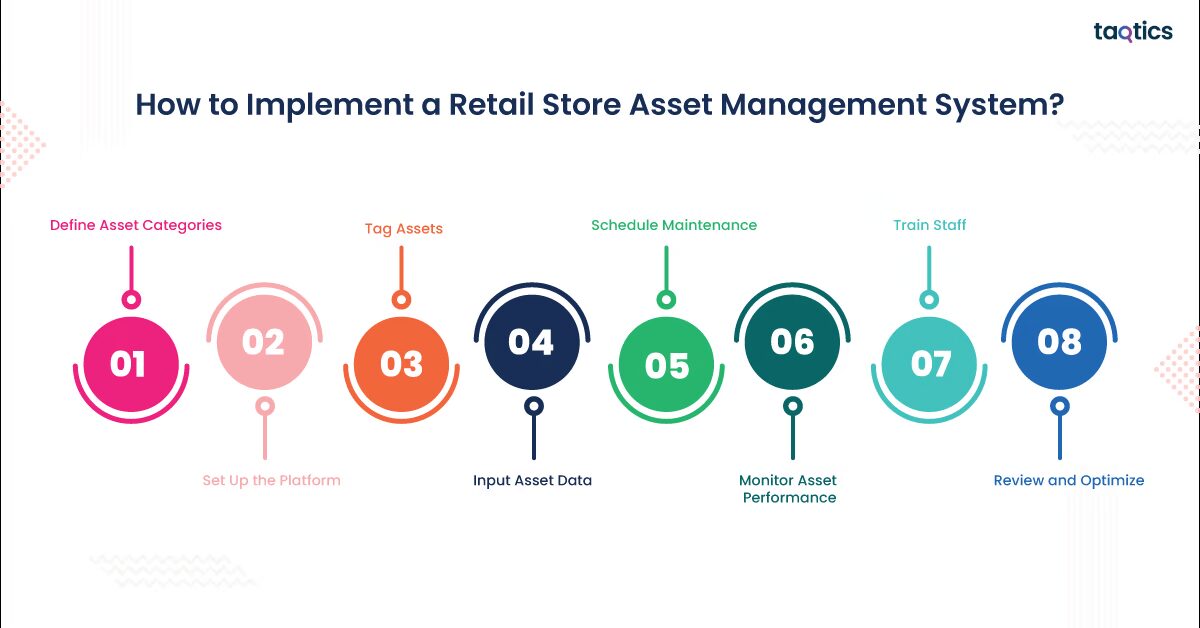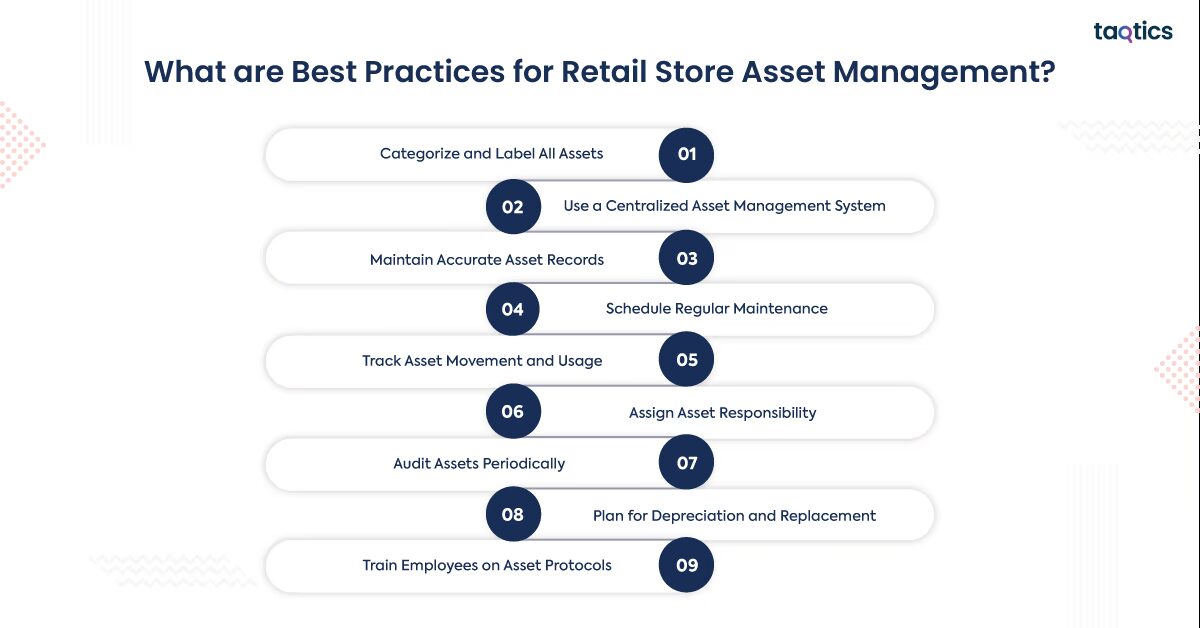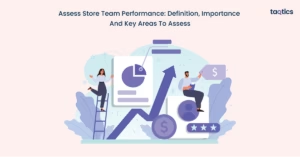Retail Store Asset Management: Overview, Types of Assets, Software to Use, Implementation Guide

Retail store asset management is a strategic process focused on tracking, maintaining, and optimizing both physical and digital assets within the retail environment. These assets include inventory, store fixtures, equipment, furniture, real estate, IT infrastructure, and customer data. According to a study by Deloitte, efficient asset management can reduce operational costs by up to 20% and improve asset utilization by 30%.
Retailers using structured asset management tools, like Taqtics, experience smoother store operations, lower downtime, and increased ROI. In fact, companies implementing automated asset tracking have reported a significant improvement in asset visibility and reduction in loss and theft. By streamlining how assets are used and maintained, businesses not only save costs but also deliver a better customer experience, support sustainability goals, and scale operations with confidence.
What is Retail Store Asset Management?
Retail store asset management is a strategic process of tracking, maintaining, and optimizing all physical and digital assets within a retail environment. Retail store asset management includes managing equipment (e.g., point-of-sale systems, shelving, lighting), inventory, signage, and IT infrastructure. Effective asset management ensures operational efficiency, reduces costs, minimizes downtime, and extends asset life.
The key aspects include:
- Inventory Management: Monitoring stock levels to avoid overstocking or stockouts.
- Equipment Maintenance: Regular servicing of tools and machinery to prevent breakdowns.
- Asset Tracking: Using barcodes, RFID, or IoT to locate and manage assets in real time.
- Compliance & Safety: Ensuring assets meet safety regulations and standards.
- Lifecycle Management: Planning asset procurement, usage, and disposal effectively.
By streamlining asset usage and upkeep, retailers improve customer experience, support sustainability, and enhance profitability.
What are The Types of Assets to Track in Retail Store?
The types of assets to track in retail store are inventory, store fixtures and fittings, equipment, real estate, vehicles, furniture, software licenses, trademarks and patents, and customer data.
Inventory
This includes all goods available for sale, promotional items, and seasonal stock. Accurate tracking is vital to prevent stockouts or overstocking. Tools like barcode scanners, RFID tags, and inventory management software (e.g., Zoho Inventory or NetSuite) help monitor real-time stock levels. Here, tracking T-shirt sizes and colors across multiple locations is a good example to cite.
Store Fixtures and Fittings
These are non-movable assets like shelves, display racks, signage, and lighting used to organize and present products. One can use asset management software to log their location, installation date, and maintenance schedule. For example, recording the placement and condition of branded display stands.
Equipment
This includes POS systems, barcode scanners, HVAC units, and cleaning machines. You can tag each item with a unique ID and use software like UpKeep to schedule regular maintenance.
Tracking service intervals for receipt printers is an example.
Real Estate
This type of asset covers owned or leased retail spaces. Real estate assets can be tracked using property management systems or spreadsheets with lease details, renewal dates, and related expenses. Monitoring lease agreements across a chain of stores is a good example to cite here.
Vehicles
Delivery vans or service vehicles fall under this category. Fleet management software with GPS tracking can be used to monitor location, mileage, and maintenance. Businesses keeping service records for delivery trucks are already into real-time tracking of these assets.
Furniture
Items such as desks, chairs, checkout counters, and storage cabinets. These are tracked by tagging each piece and logging purchase dates, depreciation schedules, and condition updates.
For example, managing replacement cycles for staff breakroom furniture.
Software Licenses: Retail stores often use software for POS, accounting, or CRM. License tracking tools help manage renewal dates, user access, and compliance. Tracking expiration dates for Microsoft Office licenses can be an example here.
Trademarks and Patents
Intellectual properties like brand logos, slogans, and product designs should be monitored for legal protection and renewal dates. Use IP management tools to stay updated. Renewing a trademark for a store’s logo is one of the examples for this category of assets.
Customer Data
This type of assets includes personal details, shopping behavior, and preferences. Secure this data using CRM systems, and customer experience retail management software and ensure compliance with data privacy regulations. For instance, using purchase history to personalize email campaigns.
Tracking these assets helps prevent loss, optimize usage, schedule maintenance, and support better budgeting decisions.
Which Software to Use for Retail Asset Management?
Taqtics is the software to use for retail asset management. It offers a comprehensive solution designed to streamline operations and enhance efficiency across multiple stores.
- Real-Time Asset Tracking: Monitor assets like laptops, equipment, and store licenses digitally, ensuring timely maintenance and reducing unexpected breakdowns.
- Automated License Management: Stay compliant with automated reminders for license renewals, helping you avoid legal penalties.
- Bulk Asset Creation: Easily add and manage multiple assets simultaneously, simplifying large-scale asset tracking.
- Barcode Integration: Utilize barcode scanning for quick and accurate asset tracking across different locations.
- Mobile Accessibility: Access the platform via web, Android, and iOS, enabling seamless data entry and report generation on the go.
Taqtics empowers retailers to maintain control over their assets, ensuring smooth operations and compliance across all outlets.
How to Implement a Retail Store Asset Management System?
To implement a retail store asset management system, retailers can follow the eights steps, which include defining asset categories, setting up the platform, tagging assets, providing input asset data, scheduling maintenance, monitoring asset performance, training staff, reviewing and optimizing system.

- Define Asset Categories: Identify and categorize all assets, including equipment, fixtures, and licenses.
- Set Up the Platform: Configure Taqtics to align with your store’s specific needs, creating asset categories and assigning user roles.
- Tag Assets: Assign unique identifiers to each asset using barcodes or QR codes for easy tracking.
- Input Asset Data: Enter detailed information for each asset into Taqtics, including purchase date, warranty, and maintenance schedules.
- Schedule Maintenance: Utilize Taqtics’ automated reminders to schedule regular maintenance and ensure compliance with legal requirements.
- Monitor Asset Performance: Use real-time tracking features to monitor asset conditions and performance, facilitating timely interventions.
- Train Staff: Provide training to your team on using Taqtics for asset management to ensure consistent and accurate usage.
- Review and Optimize: Regularly assess asset performance and make necessary adjustments to optimize resource utilization.
By following these steps, a store asset management system helps streamline asset management processes, enhancing operational efficiency and compliance.
What are the Benefits of Effective Asset Tracking in Retail?
The benefits of effective asset tracking in retail are improved operational efficiency, reduced asset loss and theft, cost savings, accurate inventory management, data-driven decision-making, regulatory compliance, enhanced accountability, better customer experience, and centralized visibility.
- Improved Operational Efficiency
Real-time tracking reduces downtime by ensuring that equipment and inventory are available when needed. - Reduced Asset Loss and Theft
With barcodes, RFID, and digital logs, retailers can better monitor assets and reduce shrinkage. - Cost Savings
Preventive maintenance and timely replacements extend asset lifespans, lowering repair and replacement costs. - Accurate Inventory Management
Helps maintain optimal stock levels, reducing overstocking or stockouts, and improving sales. - Data-Driven Decision Making
Insights from asset usage and performance support smarter purchasing, budgeting, and planning. - Regulatory Compliance
Keeping up with equipment certifications, software licenses, and safety standards helps avoid penalties. - Enhanced Accountability
Assigning responsibility for assets boosts accountability among staff and improves asset care. - Better Customer Experience
Functional equipment, accurate inventory, and well-maintained stores contribute to smoother shopping experiences. - Centralized Visibility
Retailers can track assets across multiple locations from a single dashboard, increasing transparency and control.
Effective tracking of physical and digital assets contributes to smoother operations, cost savings, and enhanced customer satisfaction. Implementing effective asset tracking transforms retail operations into a more organized, responsive, and cost-effective system.
What are Best Practices for Retail Store Asset Management?
The best practices for retail store asset management include categorizing and labeling all assets, using a centralized asset management system, maintaining accurate asset records, scheduling regular maintenance, tracking asset movement and usage, assigning asset responsibility, audit assets periodically, planning for depreciation and replacement, and training employees on asset protocols.

- Categorize and Label All Assets
Clearly categorize assets (inventory, equipment, furniture, etc.) and use barcodes or QR codes for easy identification and tracking. - Use a Centralized Asset Management System
Implement platforms like Taqtics to manage all asset data, schedules, and locations from one centralized dashboard. - Maintain Accurate Asset Records
Keep detailed records including purchase dates, warranty information, maintenance history, and asset condition. - Schedule Regular Maintenance
Set automated reminders for maintenance to extend asset lifespan and prevent unexpected failures. - Track Asset Movement and Usage
Monitor when and where assets are used to reduce misplacement, theft, and unnecessary purchases. - Assign Asset Responsibility
Designate individuals or teams responsible for specific assets to increase accountability and care. - Audit Assets Periodically
Conduct regular audits to verify records, identify discrepancies, and ensure asset accuracy. - Plan for Depreciation and Replacement
Track asset lifecycle and plan replacements in advance to avoid service disruptions. - Train Employees on Asset Protocols
Ensure all staff understand the importance of asset management and how to use the system effectively.
Effective retail store asset management relies on following best practices that ensure assets are used efficiently, maintained properly, and tracked accurately. These practices help improve efficiency, reduce costs, and enhance store performance.
How to Overcome Common Challenges in Retail Asset Management?
To overcome common challenges in retail asset management, businesses can implement a digital asset management system, use a barcode and QR code tagging, standardize asset entry and tracking processes, schedule preventive maintenance, train staff on asset protocols, assign asset ownership, conduct regular audit, and integrate asset tracking with other systems.
- Implement a Digital Asset Management System
Use platforms like Taqtics to centralize asset data, automate tracking, and eliminate manual errors. - Use Barcode and QR Code Tagging
Assign scannable codes to assets to ensure accurate identification, easy tracking, and faster audits. - Standardize Asset Entry and Tracking Processes
Create consistent procedures for asset logging, updating, and monitoring to avoid data gaps or confusion. - Schedule Preventive Maintenance
Use automated reminders to keep equipment in good condition, reducing downtime and repair costs. - Train Staff on Asset Protocols
Educate team members on proper handling, tracking, and reporting procedures to ensure consistent practices across locations. - Assign Asset Ownership
Allocate responsibility for key assets to specific team members to boost accountability and reduce negligence. - Conduct Regular Audits
Periodically verify assets against records to identify discrepancies, missing items, or inactive assets. - Integrate Asset Tracking with Other Systems
Link asset data with inventory, POS, or maintenance systems for real-time visibility and better decision-making.
Retail asset management comes with several challenges, including asset misplacement, inefficient tracking, and maintenance issues. However, the knowing common challenges in retail operations and solutions can help effectively apply the right strategies and tools. Applying relevant solutions can streamline operations and improve asset performance across all retail locations.



